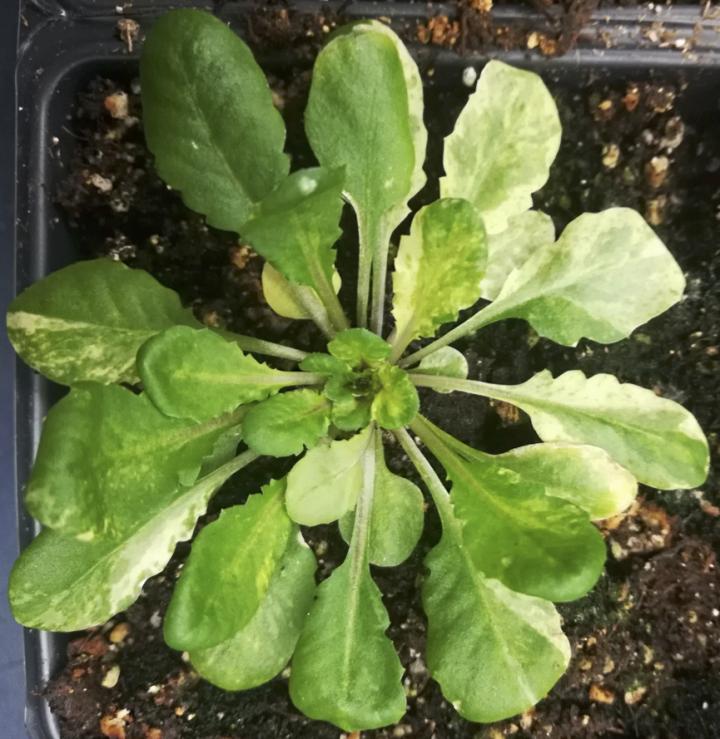
IMAGE: Arabidopsis plant that lacks functional copies of MSH1. Researchers investigated the role of this gene in mitochondrial genome stability.
view more
Credit: Dan Sloan/Colorado State University
One could say that mitochondria, the energy-producing organelles inside every human cell, dance to their own beat. After all, they have their own genome - a set of DNA-containing chromosomes – completely separate from the genome of the cell’s nucleus.
Mitochondria are essential to life because they power the cell’s biochemical reactions, but they make a lot of missteps – that is, their genomes do. Human mitochondrial genomes are notoriously prone to mutation, which is why so many genetic disorders – from diabetes mellitus to mitochondrial myopathy – are linked to malfunctioning genes in this organelle.
Seeking to understand why human mitochondrial genomes mess up so much, Colorado State University biologist Dan Sloan thinks we have a lot to learn from our very distant evolutionary cousins – plants. Like us, plants maintain a separate mitochondrial genome, but unlike us, plant mitochondrial genomes have some of the slowest known mutation rates of any living thing – about one mutation at each DNA position in a billion years. Just how they keep their genetic sequences on lockdown, while we don’t, has long been a mystery for many biologists.
Sloan is funded by a grant from the National Institutes of Health to investigate why plants have such stable mitochondrial genomes, and his lab has recently come across a tantalizing lead. They have traced this stability to a particular gene – MSH1 – that plants have but animals (including us) don’t. Their experiments, described in Proceedings of the National Academy of Sciences, could lend insight into why animal mitochondrial genomes tend to mutate, possibly leading to breakthrough therapies to prevent such mutations.
“Understanding how some systems have been able to maintain these really accurate, low mutation rates, sets up the opportunity for understanding the flip side of the coin – how it is that humans suffer such high mitochondrial mutation rates,” said Sloan, associate professor in the Department of Biology. “It’s not as simple as just the nasty chemistry going on inside these mitochondrial compartments, as some have thought. It probably comes down to more differences between organisms’ error correction machinery. That’s one of the punchlines that comes out of this research.”
The researchers tested several plant genes they thought might be responsible for mitochondrial genomic stability. They found that disrupting the MSH1 gene in a common plant, Arabidopsis thaliana, led to massive increases in frequency of point mutations and changes to the mitochondrial DNA. MSH1, it turns out, contains molecular features that may make it able to recognize mismatches of nucleotide base pairings during the process of DNA copying. They researchers plan to follow up on this hypothesis in later studies.
The MSH1 gene exists in plants, but not animals, which offers a good explanation for why human mitochondrial genomes mutate so often. The researchers then asked, where did this gene come from?
To find an answer, undergraduate researcher and paper co-author Connor King set out to explore the distribution of the gene across the tree of life. He computationally mined nucleotide and protein sequence repositories to find what species have the gene. He found evidence of the gene not only in plants but also in many lineages of complex organisms, including single-celled eukaryotic organisms, as well as some prokaryotic and viral species.
King’s analysis raises the possibility that the gene came from so-called giant viruses that have genomes almost the size of bacteria, and are much more complex than typical viruses. They may have been shared with other organisms via an ancient horizontal gene transfer, in which one species transfers DNA into another.
“Connor’s results pretty clearly tell us that this gene has been transferred around different parts of the tree of life,” Sloan said. This insight would be consistent with the idea that some organisms manage to borrow machinery from viruses and replace it with their own.
The study was made possible by advanced DNA sequencing, in which huge amounts of DNA can be mined to find very rare mutations. A key enabling innovation was led by graduate student and co-author Gus Waneka, who customized a technique called duplex sequencing to increase its accuracy within the margin of error the team needed to draw their conclusions.
###
Link to paper: https:/
TDnews














